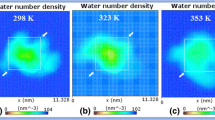Abstract
A study has been undertaken of stress relaxation in ovalbumin thermotropic gels with a concentration of 8–20%, depending on time and temperature of heating (respectively, 20–60 min, 70°–110°C), at pH 2.5–10.0. In all instances, the dependence of the initial gel elasticity modulus on heating has a single maximum. Gelation conditions corresponding to this maximum are considered optimal. Optimal gelation time is 30 min, regardless of pH. On the other hand, the optimal heating temperature depends on pH. To the right and left of the isoelectric point of protein (2.5≤pH<4.0 and 5.5<pH≤10.0) the optimal temperature is 80°. However, in the vicinity of the isoelectric point (4.0≤pH ≤5.5) the optimal temperature rises considerably. Gels produced to the right and left of the isoelectric point belong to the homologous group A, while gels produced in the point vicinity belong to another homologous group B. Light scattering data proves group A gels to be more homogeneous optically. These gels may be supposed a single-phase system, while group B gels are two-phase-systems. For each group, the dependence of the relaxation modulus (G) of gels on heating conditions, pH and protein concentration (X 1,X 2,X 3,X 4), as well as on time of relaxation (t) may be generally described asG(X 1,X 1,X 1,X 1,t)=G e(X 1,X 2,X 3,X 4)f(t), whereG e is the equilibrium value of the elasticity modulus, and f(t) the relaxation function. Thus, a change in the parameters only affects the value of the equilibrium elasticity modulus, and exerts no effect on the relaxation time spectrum. For this reason, all the relaxation curves obtained may be transformed into two normalized relaxation functions:∼f(t)=f(t)/f(1)=G(X 1,X 2,X 3,X 4,t)/G(X 1,X 2,X 3,X 4, 1)
Each of these normalized functions corresponds to one of the homologous groups. Rheological similarity of gels in each homologous group evidently points to their structural similarity. Invariance of the gel relaxationproperties with regard to protein concentration, leads to a concentration dependence of the equilibrium modulus at various pH values. These dependences are curvilinear on a double logarithmic scale. The slope of the curve exceeds 2 in the entire concentration interval studied. In other words, the dependences obtained cannot be described by the usual “law of squares”. On the other hand, they adequately match Hermans theoretical relation for a network formed by random association of identical polyfunctional particles without cyclization. This simple model evidently gives a true picture of the major regularities of thermotropic gelation for ovalbumin. An agreement between this theory and experiment was achieved for a protein concentration ofC *=6.0±1.0% at the gel point regardless of pH. Invariance of gelpoint position with regards to pH demands further confirmation.
Similar content being viewed by others
Abbreviations
- T h,t h :
-
heating temperature and time
- T *h ,t *h :
-
optimal heating temperature and time
- C :
-
protein concentration
- C * :
-
protein concentration in gel-point
- G :
-
relaxation modulus
- G e :
-
equilibrium modulus
- f(t) :
-
relaxation function
- t :
-
time of relaxation
- ∼f(t) :
-
normalized relaxation function
- ∼fT A (t), ∼f B (t) :
-
normalized relaxation functions of groups A and B
- ∼G 1 :
-
T h,t h-reduced modulus
- ∼G 2 :
-
T h,t h, pH-reduced modulus
- ∼G 3 :
-
C-reduced modulus
- b 1 :
-
T h, th reduction parameter of modulus
- b 2 :
-
pH reduction parameter of modulus
- b 3 :
-
C reduction parameter of modulus
- Wg :
-
gel-fraction
References
Bibkov TM, Grinberg VYa, Schmadke H, Chaika TS, Vaintraub IA, Tolstoguzov VB (1981) Coll & Polym Sci 259:536–547
Wolf WJ, Cowan JC (eds) (1971) Soybeans as a Food Source, Butterworths, London, pp 34–77
Wolf WJ (1969) Baker Digest 43:30–37
Wolf WJ (1972) In: Smith AK, Circle SJ (eds) Soy Beans: Chemistry and Technology, Vol 1, AviPublishing Co, Inc, Westport pp 93–143
Vaintraub IA (1975) In: Vegetable Proteins and their Biosysthesis, Nauka, Moscow, pp 142–152
Bibkov TM, Grinberg VYa, Danilenko AN, Chaika TS, Vaintraub IA, Tolstoguzov VB (1985) J Agric Food Chem 33:912–918
Taborsky G (1974) Adv Prot Chem 28:34–91
Osuga DT, Feeney RE (1977) In: Whitaker JR, Tannenbau SR (eds) Food Proteins, Avi Publishing Co Inc, Westport, pp 221–222
Van Kleef FSM, Boskamp JV, van den Tempel M (1978) Biopolymers 17:225–235
Tandord C (1968) Adv Prot Chem 23:121–211
Egelandsdal B (1980) J Food Sci 45:570–573, 581
Bibkov TM, Grinberg VYa, Tolstoguzov VB (1979) Die Nahrung 23:403–408
Lee EH, Radoka JRM (1960) J Appl Mech 27:438–444
Kegeles G, Gutter FJ (1951) J Am Chem Soc 73:3770–3777
Bibkov TM, Grinberg VYa, Tolstoguzov VB (1979) Die Nahrung 23:487–494
Bibkov TM, Grinberg VYa, Antonov YuA, Tolstoguzov VB, Schmandke H (1979) Polymer Bull 1:865–869
Hermans JJr (1965) J Polym Sci A3:1859–1868
Privalov PL (1979) Adv Prot Chem 33:167–241
Vinogradov GV, Malkin AYa (1977) Polymer Rheology, Khimiya, Moscow, pp 71–72
Duŝek K, Prins W (1969) Adv Polym Sci 6:1–102
Author information
Authors and Affiliations
Rights and permissions
About this article
Cite this article
Grinberg, N.V., Bibkov, T.M., Grinberg, V.Y. et al. Thermotropic gelation of ovalbumin 1. Viscoelastic properties of gels as a function of heating conditions and protein concentration at various pH values. Colloid & Polymer Sci 266, 52–59 (1988). https://doi.org/10.1007/BF01451532
Received:
Accepted:
Issue Date:
DOI: https://doi.org/10.1007/BF01451532




